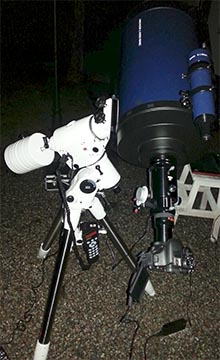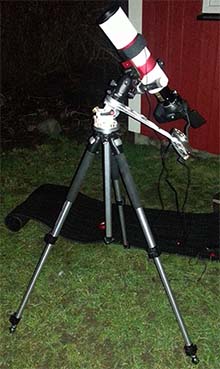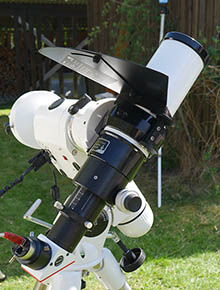Telescopes
Meade 10" LX-50 with Skywatcher NEQ6 Pro mount
My flagship telescope. Bought this new back in 1999 together with a Meade Superwedge. The biggest advantage of this scope is its size. The biggest drawback of this scope is its size. Though it's nice to have big aperture it also gets pretty hefty. One day I will have an observatory, then the size of the scope won't be any issue. The optical quality is excellent and I've always been very happy with the optical performance of this telescope. My best memory is looking at Jupiter and Saturn one night from my mothers balcony with it. The sky was unusually stable this night and the views were tack sharp! To have full go-to capability I de-forked the 10" SCT optical tube assembly in 2013 and bought a Skywatcher NEQ6 Pro mount. This mount gave me a longed-for goto-capability and a really good working autoguiding functionality. The goto works like a charm, and when using 3-star alignment I get the object in the FOV even with large magnification. The autoguiding worked perfectly the first time I used it. The NEQ6 Pro mount is one of the few things in this hobby that has never caused me any trouble.
Telescope facts:- Meade 10" LX-50 EMC Schmidt-Cassegrain
- Optical diameter: 250mm (10")
- Focal Length: 2500mm
- Focal Ratio (Photographic Speed): f/10
- Limiting Visual Magnitude (approx.): 14.5
- Primary & Secondary Mirrors: Pyrex ® glass
William-Optics ZenithStar 71 and Astrotrac TT320X-AG
Without any doubt my mostly used configuration/telescope. The reason? It's lightweight and easy to setup. The refractor gives pinpoint stars and virtually no false colours, making it a real joy to use. The astrotrac system is extremely precise, and best of all its very easy to setup and start photographing the sky. Typically, seting up the telescope together with the tripod and the astrotrac and setting it up to north pole takes about 10-15 minutes. This gives me such a good precision that I with the ZenithStar 71 (418mm focal length) without any problems can have something in the central FOV for around 45 minutes, no autoguiding and no other corrections. Setting up the LX-50 and aligning everything in order to be able to do the same thing would require at least 1.5 hours of preparations. This is the single most important reason that the ZenithStar+Astrotrac is used so often. For really small objects, like most galaxies and the planets, I however used the LX-50. The WO is also a great companion with the skywatcher NEQ6 pro mount thanks to the fact that this mount is way over-sized for this telescope and thus there are never any problems with overloading. When using this telescope together with the NEQ-mount I always use autoguiding together with a small 50mm-telescope (162mm focal length), which works just like a charm. To the telescope, I also have a 0.8x flattener/reducer (WO Field Flattener 6 #P-FLAT-F6), which give me an effective focal length 334mm and a focal ratio of f/4.7.
Telescope facts:- William Optics ZenithStar 71 ED
- Optical diameter: 71mm
- Focal Length: 418mm (334mm with focal reducer)
- Focal Ratio (Photographic Speed): f/5.8 (f/4.7 with focal reducer)
Lunt LS60THa
Even though I've used a standard solar filter for quite some time, I've always wanted to have a h-alpha telescope. This type of telescope will sort out certain wavelengths of the visible spectrum from the sun. The H-alpha optics makes it possible to se granulations and prominences, something you can’t see with an ordinary sun blocking filter. Unfortunately these telescopes are usually pretty expensive. Now this telescope came out as a second hand for a really good price, and me and Leif bought it together. It's a really fantastic telescope which gives views of the sun that you never forget. We have been lucky to being able to use it for the Mercury transit in 2016.
Telescope facts:- Lunt LS60THa solar telescope tilt-tuned
- Optical diameter: 60mm
- Focal Length: 500mm
- Focal Ratio (Photographic Speed): f/8.3
Lotus RT-480
My portable telescope that also serves as a guidescope to the LX-50. The views are very wide-field (thanks to the low focal length), and together with a 1.25" ultra-wide the image is clear, bright and crisp. But as most achromats, I get false color at the edge of bright objects. I never use the 8X21-finder, as the views with a long focal length eyepiece are wide enough to do a search on the sky. Also, the focuser feels pretty plastic and when I go high-power under steady nights it might be a little troublesome to get perfect focus. But considering what I payed for it ($50 US completely new), I feel it was a bargain. With the telescope a 1.25" 45 degree right-angle correcting prism was included, which I have switched for a 1.25" Meade 90 degree diagonal of higher quality. When I use it as a guidescope, I add a 2X barlow to get a focal length of 800mm. This is still short, but with my reticle eyepiece it gives enough magnification for guiding. What I think is nice with this scope is that the color matches perfect with my LX-50, so it looks nice on top of the large scope. One other good thing is that it has a standard 0,25" thread on the bottom, so it can be used with any regular photo-tripod. When I want to go mobile, I use this scope with a Manfrotto tripod. Since I have the APO now I usually just use this telescope for autoguiding nowadays.
Telescope facts:- Lotus RT-480 Telescope
- Optical diameter: 80mm lens (3.1 inch)
- Focal Length: 400mm
- Focal Ratio (Photographic Speed): f/5




